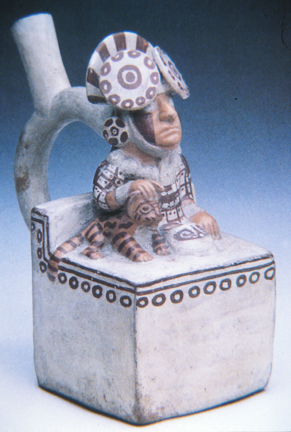The Moche culture dominated the north coast of Peru during the Classic Period (250-900 CE). Moche lords held sway over each river valley from ceremonial and administrative centers built of unfired clay brick, which understandable have not survived the ravages of time and weather. The Moche were influenced artistically by the preceedcing Cupisnique and Tembladora cultures. The vessel is representative of Moche pottery in several ways. First is the unique and distinctive stirrup spout at the rear of the piece. It serves as both a handle and a pouring spout. The Moche also used polychrome slips on their coil built or molded ceramic objects. White, brick, and black are typical colors. Here a Moche lord is seated atop a raised platform, possibly a throne, wearing an elaborate headdress with a chin strap and large earplugs. His face is painted in a manner typical of what is seen in depictions of rulers. His upper body is painted with a design representing a hinged tunic. He strokes the head of a cat or a jaguar cub, the jaguar being a tractional symbol of power. Vessels of this kind were used in Moche rituals, and were treasured as luxury items, and buried in large quantities with individuals of high status.
A central theme of Moche art is the sacrificial ceremony in which prisoners who were captured in battle are sacrificed and several elaborately dressed figures drink their blood. The central figure was the warrior priest, a role assumed by the ruling lord.

Moche stirrup spout vessel with seated lord, from the Moche Valley, North Coastal Peru
Classic Period, 200-500 CE


